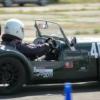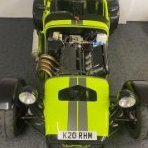Leaderboard
Popular Content
Showing content with the highest reputation on 03/06/12 in all areas
-
It is indeed one of the great privileges of my life to have flown a Spitfire, albeit a two seater, whatever you feel when you hear that noise, imagine what it's like when it's wrapped around you A Spitfire needs to flown all the time, it is nothing like as stable as a Hurricane, particularly in pitch, which is why the Hurricane was a better gun platform. Early marks required the pilot, immediately after take off, to change hands on the stick, reach down with the right hand and vigorously pump the undercarriage retraction lever, the result was almost always porpoising as it was almost impossible to keep your left hand still while pumping with your right, a bit like trying to pat your head and rub your tummy at the same time. As close to handling perfection as I have found, the Spitfire suffered early in WW2 when faced with 109's which could evade contact by simply pushing forward into a vertical dive, the 109 had a fuel injected engine whereas the Merlin used carburetors with a float, when the Spitfire pilot pushed over to follow the 109 the negative G caused the float to rise and block fuel flow for the duration of the manoeuvre. The Merlin would cough and splutter for a few vital seconds or the Spitfire pilot would have to roll inverted and pull through, either way the result was a couple of seconds of breathing space for the German, until some bright bod invented the floatless carburetor which, when fitted, soon saw the Luftwaffe pilots change tactics! There is nothing to compare with flying a Spitfire... except possibly a T7A Hunter... but that's another story G-BOOM on the left, G-HUNT on the right, strangely the side by side 2 seater was 7kts faster than the single seater2 points
-
Running in a Borough 19 Sprint at Snetterton today I slid off in the wet, and boy was it wet, end result was a broken steering. With a soaking wet racesuit and feeling frozen I decided to change in the restaurant area and warm up with a cup of tea before trying to get the car onto the trailer. We got back to find the only two other Westfield members there, Matt Hillan and Pete Goulding leading a group loading the car for me. Thanks guys you'll never know how much that was appreciated, another great example of that Westfield camaraderie.1 point
-
There are too Mosquito replicas in production at the monemt. That will both be airworthy. Can't wait for that.. Miss Shilling's Orifice was a very simple technical device made to counter engine cut-out in early Spitfire and Hurricanee fighters. It was officially called the R.A.E restrictor, but was normally referred to under various names, such as Miss Tilly's Diaphragm or the Tilly orifice in reference to its inventor, Beatrice "Tilly" Shilling. The early versions of the Rolls-Royce Merlin engine came equipped with an SU carburettor. When these aeroplanes performed a negative G force manoeuvre (pitching the nose hard down), fuel was forced upwards to the top of the float chamber of the carburettor rather than into the engine, leading to loss of power. If the negative G continued, the fuel would collect in the top of the float chamber, forcing the float to the floor of the chamber. This would in turn open the needle valve to maximum, flooding the carburettor with fuel and drowning the engine with an over-rich mixture. This would lead to a rich mixture cut-out, which could shut down the engine completely (a serious drawback in combat) Negative G commonly occurs when manoeuvring to fire on an enemy aircraft in a dogfight. Moving the stick forward would starve the engine of fuel, producing a sudden loss of power. This would let the enemy get away, and if continued the manouver would cause the carburettor valve to open, provide far too rich a mixture and kill the engine. During the Battles of France and Britain the German fighter aircraft had fuel injected engines and therefore did not suffer from this problem as the fuel injection pumps kept the fuel at a constant pressure whatever manoeuvre were made. The German pilots could exploit this by going into a steep dive while pushing the throttle wide open, the pursuing British aircraft being left flat footed since trying to emulate the manouver would result in loss of power, or fuel flooding and engine shutdown. The British countermeasure, a half roll so the aircraft would only be subjected to positive G as they followed German aircraft into a dive, took enough time to let the enemy escape in most instances. Compliants from pilots led to the search for a solution. Beatrice "Tilly" Shilling, a young engineer working at the Royal Aircraft Establishment (RAE) at Farnborough, came up with a didarmingly simple solution. She introduced a simple flow restrictor: a small metal disc much like a plain washer. The restrictor orifice was made to just accomodate the fuel needed for maximum engine power, the setting usually used during dogfights. While not solving the problem fully, the restrictor, along with modifications to the needle valve, permitted pilots to perform quick negative G manoeuvres without loss of engine power, removing the annoying drawback the British fighters had had in comparison to the German Messerschmitt Bf 109 which was equipped with fuel injection. Miss Shilling with a small team travelled around the countryside in early 1941 fitting the restrictors, giving priority to front-line units. By March 1941 the device had been installed throughout RAF Fighter Command. The device was immensely popular with pilots, who affectionately named it 'Miss Shilling's orifice' or simply the 'Tilly orifice'. This simple and elegant solution was only a stopgap, it did not allow inverted flight for any length of time. The problems were not finally overcome until the introduction of Bendix and later Rolls Royce pressure carburettors in 1943. Chaz.1 point
-
1 point
-
Quick fix? How long have the current management been in place? I think it's 6 years or thereabouts. More than long enough to sort this issue out. For me this raises far more fundamental questions. A car, whether or not it's a toy, is a big ticket item. A spcialist car company, who can see the order book well in advance has litle excuse IMHO. And like us, if their current supplier can't deliver, find one who can. I can get everything I need with zero buying power, but Westfield can't despite in theory having significantly better buying power than me. Why is this?1 point
-
I am not a supporter of poor service, but and its a big but, for those who haven't realised it we are part way into a second recession which means companies are folding all over the place including vehicle parts suppliers. We are in some ways fortunate that Westfield has survived so far. Westfield are a very small company and yes we can all pick holes in some of there activities but if we really expect everything tomorrow maybe we should reprogramme ourselves, because sometimes it isn't going to happen. Some well positioned companies can do it and have delivered next day, various parts and accessories but they are not the norm and we shouldn't expect it. My mate who has a garage just rings his motor factor and the parts are delivered generally within a couple of hours. It is very dissappointing to order a kit and to find parts are missing, it happened to me. But would I delay collection for a clutch pedal stop bolt (a favourite miss) or the odd piece, I guess not, dissappointed yes but in reality Westfield need to get the kits out of the door and we want the kits or parts to start/continue/build our cars. Should they ring you up and offer you a delay in collection due to a couple of missing parts caused by suppliers, I suppose so, then we would be ******ging them off for late delivery. This is a knock on effect of the world we have allowed to develop over the years and hindsite is fine. We expect far too much and kick off when it doesn't happen, but then we shouldn't be mislead by companies either. If the banks, politicians, countries can get away with it who are we to expect any less. I have lost count of businesses I have dealt with who failed to deliver but have been impressed with some who do the business efficiently.I can remember ordering numerous new cars with a 6-8 week delivery to be fobbed off with theirs a shortage of wheels (three times that happened--Bullsh!t) I would advocate patience, it is frustrating but unless the panels or suspension parts are missing there should always be something to get on with in a new build and as mentioned a lot of parts can be sourced elsewhere which isn't really supporting Westfield is it. New builders won't be aware of the numerous part numbers and interchangeable items but with a bit of patience and planning it can and will be completed. It took me over 6 months to get the exhaust I wanted back into manufacture and supplied. Patience is truly a virtue, hard to take when it happens to you but when you look back after you have been through IVA it will all fade away, hopefully. Then you will have a big daft grin on your face. Bob1 point
-
indeed I dropped Ross a text earlier as i knew he was after some John, and if you see the things his car has on you will understand why, they r like something from world war 1 :laugh:1 point
-
Go to dot 5 fluid, really good braided lines and try mintex pads, then change the calipers if you have to. I did not like the green stuf pads, found the mintex better for feel, but others will disagree. That said the Ferodo Ds were good as well....for me, so try a few to find what works for your style. The ultralight and other direct replacements are in terms of spacings and fitting, but require more fluid for the same pressure due to the sizes of the pistons. as a result you might find that your pedel feels initially longer dead travel then more solid. To some this is fine as the solid reasuance is enought....others find the dead travel unnerving.....the bigger MC fills the dead peddle bit to give you reasurance. However if you can lock the brakes with the M16's you do not need better brakes as they can already overpower the grip available so perhaps better tyres/suspension/Geo setup/ARB would be the move for you? Also when very light the alloy housing will flex and this will give a really odd braking feel when really on a hot blat. Sometimes the slightly heavier and stronger calipers are the better ones. IMHO these ultralights are right on the boarded for a typical westfield. I think they are rated for 700Kg cars and while everyones thinks there westy is 580Kgs or similar....it will be very close or more to 700kgs full of fluid and 2 up.1 point




